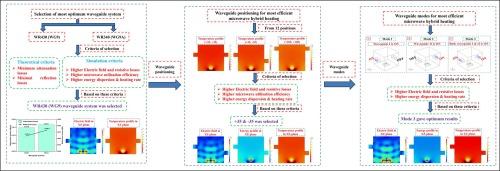A sustainable waveguide-based design strategy for improving the energy efficiency of microwave hybrid heating systems: A combined theoretical and multi-physics simulation approach
IF 5.1
3区 工程技术
Q2 ENERGY & FUELS
引用次数: 0
Abstract
The microwave hybrid heating (MHH) based processing has emerged as energy-efficient and productive manufacturing process. The efficiency of MHH depends upon the ability of waveguide system to transmit the electromagnetic radiation with minimal loss. Thus to improve the efficiency of MHH it is of paramount importance to understand the potential of waveguide systems. In the present work, the influence of different waveguide systems, their positioning, and different modes of operation on MHH efficiency were studied via theoretical and simulation investigations followed by experimental validation. Based on the study, the optimum waveguide system was identified as WR430. To assess the efficiency and effectiveness of the waveguide positioning on MHH, 12 different locations were considered, and the optimum location was identified as (+35, −35), with a maximum microwave utilization efficiency of 44.5 %. Subsequently, the simulation model (1049 °C) was validated using experimental data (1017 °C) with an error of less than 10 %. Also, MHH is sensitive to different waveguide operating modes, SiC susceptor positioning and microwave power. A microwave cavity operating with two waveguides on both sides is found to provide optimum results in terms of heating uniformity, electric field distribution, and microwave energy absorption. The SiC susceptor positioned at the centre of the alumina refractory yields maximum heat evolution of 1020 °C. In addition, as the microwave power grows, the temperature differential also increases, implying thermal heterogeneity inside the SiC susceptor. Thus, low microwave power is identified for improved thermal uniformity and energy efficiency, while high power is proven for rapid differential microwave heating.

提高微波混合加热系统能效的基于波导的可持续设计策略:理论与多物理场仿真相结合的方法
基于微波混合加热(MHH)的加工已成为一种高能效、高生产率的制造工艺。微波混合加热的效率取决于波导系统以最小损耗传输电磁辐射的能力。因此,要提高 MHH 的效率,了解波导系统的潜力至关重要。在本研究中,我们通过理论和模拟研究,以及实验验证,研究了不同波导系统、其定位和不同工作模式对 MHH 效率的影响。根据研究结果,确定最佳波导系统为 WR430。为了评估波导定位在 MHH 上的效率和效果,考虑了 12 个不同的位置,确定最佳位置为(+35,-35),最大微波利用效率为 44.5%。随后,模拟模型(1049 °C)通过实验数据(1017 °C)进行了验证,误差小于 10%。此外,MHH 对不同的波导工作模式、碳化硅吸收体定位和微波功率都很敏感。在加热均匀性、电场分布和微波能量吸收方面,一个两侧有两个波导的微波腔能提供最佳结果。位于氧化铝耐火材料中心的碳化硅吸收体产生的最大热量为 1020 ℃。此外,随着微波功率的增加,温差也在增大,这意味着碳化硅吸收体内部存在热异质性。因此,低微波功率可提高热均匀性和能效,而高功率则可实现快速微波差加热。
本文章由计算机程序翻译,如有差异,请以英文原文为准。
求助全文
约1分钟内获得全文
求助全文
来源期刊

Thermal Science and Engineering Progress
Chemical Engineering-Fluid Flow and Transfer Processes
CiteScore
7.20
自引率
10.40%
发文量
327
审稿时长
41 days
期刊介绍:
Thermal Science and Engineering Progress (TSEP) publishes original, high-quality research articles that span activities ranging from fundamental scientific research and discussion of the more controversial thermodynamic theories, to developments in thermal engineering that are in many instances examples of the way scientists and engineers are addressing the challenges facing a growing population – smart cities and global warming – maximising thermodynamic efficiencies and minimising all heat losses. It is intended that these will be of current relevance and interest to industry, academia and other practitioners. It is evident that many specialised journals in thermal and, to some extent, in fluid disciplines tend to focus on topics that can be classified as fundamental in nature, or are ‘applied’ and near-market. Thermal Science and Engineering Progress will bridge the gap between these two areas, allowing authors to make an easy choice, should they or a journal editor feel that their papers are ‘out of scope’ when considering other journals. The range of topics covered by Thermal Science and Engineering Progress addresses the rapid rate of development being made in thermal transfer processes as they affect traditional fields, and important growth in the topical research areas of aerospace, thermal biological and medical systems, electronics and nano-technologies, renewable energy systems, food production (including agriculture), and the need to minimise man-made thermal impacts on climate change. Review articles on appropriate topics for TSEP are encouraged, although until TSEP is fully established, these will be limited in number. Before submitting such articles, please contact one of the Editors, or a member of the Editorial Advisory Board with an outline of your proposal and your expertise in the area of your review.
 求助内容:
求助内容: 应助结果提醒方式:
应助结果提醒方式:


